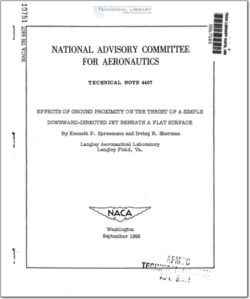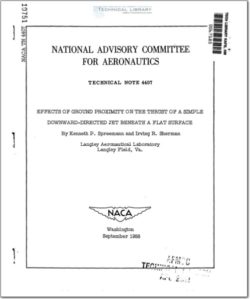NACA-TN-4407

- Version
- 189 Downloads
- 1.97 MB File Size
- 1 File Count
- March 24, 2016 Create Date
- March 24, 2016 Last Updated
National Advisory Committee for Aeronautics, Technical Notes - Effects of Ground Proximity on the Thrust of a Simple Downward-Directed Jet Beneath a Flat Surface

An investigation to determine the effects of some of the basic
parameters on the thrust of a simple downward-directed jet beneath a
flat plate has been conducted in a static-thrust facility at the Langley
Aeronautical Laboratory. Some of the principal variables investigated
were size and shape of the flat plate, aspect ratio of the plate, dis—
tance of the flat plate and nozzle exit above the ground, and surface
conditions of the ground.
Reductions in the ratio of plate area to jet area greatly lowered
the height above the ground where serious adverse ground effects were
encountered. Changes in plate aspect ratio from 1 to 3 appeared to
have little effect on the induced negative thrust in close proximity to
the ground, but at 3 and above significant reductions in the negative
thrust were obtained. Extending the nozzle below the flat plate had
little effect on the induced negative thrust at a given height of the
flat plate above the ground.
Of the various devices employed to reduce the adverse ground effects
only a perforated plate, raised slightly above the ground to provide a
new take-off and landing surface, was effective in minimizing the induced
negative thrust near the ground. The pressure ratio in the nozzle had
very little effect on the ratio of jet thrust in ground proximity to
jet thrust out of ground proximity for heights above the ground of more
than 5 nozzle diameters. very near the ground (within 1 nozzle diameter)
with one of the smaller plates investigated, increases in nozzle pressure
greatly reduced the losses in thrust.
The Langley 7- by lO-Foot Tunnels Branch is investigating various
methods of achieving vertical take—off and landing. One relatively
simple means of obtaining vertical take-off and landing is by a circular
jet directed vertically downward. It is well known that when a flat
plate with a perpendicular jet of fluid emitting from its center is
brought into close proximity with a parallel plate the two plates are
drawn together with a force exceeding the thrust of the jet. Simple
devices of this nature are used to demonstrate Bernoulli's principle.
This phenomenon would be expected to cause_some configurations of jet
vertical take-off and landing aircraft to lose lift when hovering near
the ground. The results of an investigation of a shrouded propeller sub—
merged in a wing, reported in reference l,_indicate losses in lift of
this nature in close proximity to the ground.
| File | Action |
|---|---|
| naca-tn-4407 Effects of Ground Proximity on the Thrust of a Simple Downward-Directed Jet Beneath a Flat Surface.pdf | Download |

Comment On This Post